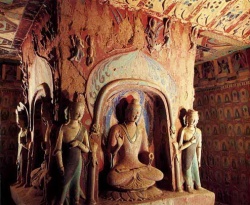Nondual Tantra
Nondual Tantra; The numerically smallest group of the three main classes of anuttara-yoga-tantras according to some adherents of the New Transmission lineage .
Tantric literature has been divided into the so-called Father Tantra (emphasizing activity, the Mother Tantra (emphasizing appreciation), and the Nondual Tantra (dealing with both aspects unitively).
The numerically smallest group of the three main classes of anuttara-yoga-tantras according to some adherents of the New Transmission lineage in Tibet.
These comprise the Kālacakra Tantra and the Mañjuśrī-nāma-saṇgīti.
Meditative practice (sādhana) based on the Non-dual Tantras emphasizes an integration of the generation and completion-phases of visualization as a means of personal transformation.
Post-10th century Tibetan classification schemes4 that were formalized by the 14th century in the structure of the Tibetan Kangyurs typically catalogue the translated texts of the Yoginītantra class, which Tibetans called “Mother tantras,” alongside what they called “Father tantras”5 and “Non-dual tantras,”6 to make up the more inclusive category of “Unexcelled Yoga Tantra” (yoganiruttara / anuttarayoga tantra).7
The Unexcelled Yoga tantras, believed by most Tibetan exegetes to be the ultimate revelation of the Buddha of our eon, therefore occupy the first major bibliographic category in the “tantra collection”8 of most Kangyur collections.
Unexcelled Yoga tantras are in turn followed by the tantra classes of “Yoga,” “Conduct” and finally “Action,” an order thought to represent along a descending gradient the relative soteriological power of the yogic techniques emphasized in each textual class.
The same hierarchical logic is also reflected in the Kangyur’s internal sub-divisions of Highest Yoga tantra itself, where the highest of the high, Non-dual tantras, are followed by Mother tantras and then by Father tantras, once again reflecting in descending order Tibetan conceptions of the relative profundity and power of each sub-class’s methodological emphasis.
In relating the rationale for this tripartite hierarchy in his commentary on the Guhyagarbhatantra, Longchenpa (klong chen rab ’byams pa dri med ’od zer, 1308–1364) echoes the following popular tantric dictum:
Father tantra primarily teaches generation stage, mother tantra primarily teaches completion stage, and non-dual tantra primarily teaches their integration.9
